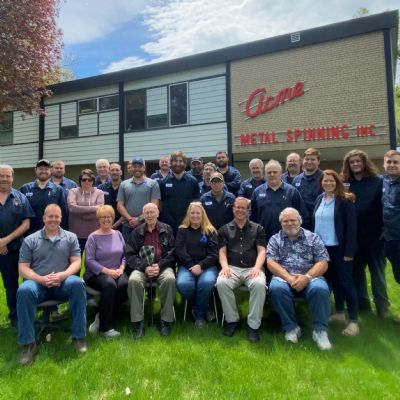 Peter Ulintz
Peter UlintzProcessing Considerations for Metal Spinning
August 25, 2019Comments
This article, the second of a series on metal spinning processes and their tools, discusses key process parameters for successful spinning. Last month’s column covered basic spinning technology and equipment.
Metal spinning imparts continuous local plastic deformation through the feeding motion of the roller(s), providing inherent advantages over global deformation processes such as deep drawing. Conversely, localized deformations make it challenging to control final part dimensions and shape.
Assessing spinnability—the ability of sheet metal to undergo deformation by spinning without wrinkling or fracturing—requires the evaluation of the workpiece, tooling and process.
Workpiece Parameters
Key workpiece parameters include material type and grade, blank thickness, blank diameter, minimum wall thickness, corner radii and part drawing conventions.
Nearly all ductile metal alloys available in sheet form, including aluminum, stainless steel, copper, brass, tin, silver and gold, are used in metal spinning.
With aluminum, there can be significant differences in mechanical behavior between different alloys and tempers. For example, AA1100-H14 can have a total elongation approaching 60 percent, making it the most formable of the aluminum alloys. Although AA3003-H14 has the same temper designation (H14), it is less formable, with approximately 30-percent total elongation.
Ferritic stainless steels such as Type 439 behave much like low-carbon steels, but require more force to cause yielding. Austenitic stainless steels such as Type 304 have total elongations exceeding 60 percent but require far greater force to continue yielding (deforming) as they rapidly strengthen due to cold working.
The ratio of blank diameter (Do) to mandrel diameter (d), known as the spinning ratio or spinning coefficient (m), is expressed as m=d/Do.
A larger value of m means a larger material deformation is possible, which implies better spinnability. Lower values of m and/or thinner blanks make the spinning process more difficult.
Obtaining uniform wall thickness during spinning generally requires a high feed ratio—the roller-feed rate relative to the spindle speed, expressed as mm/revolution or in./revolution—and the number and the direction of each roller pass. When the roller moves forward, the material thins slightly; when it moves backward, it displaces metal in the opposite direction to help maintain consistent wall thickness. Conversely, high feed ratios also can produce buckling, wrinkling, rough surface finish and dimensional variation.
Superior surface finish and improved dimensional stability, while attainable with relatively low feed ratios, comes at the expense of wall thinning and cycle time. When feed ratios are too low, excessive thinning can lead to fracturing.Another impactful factor: corner radii. This can affect spinning accuracy and wall thickness along the length of the part. Product designs should avoid sharp corners when possible and a formed radius should not be less than two to three times the blank thickness. Radii as small as one material thickness may be possible with thick blanks.
The part drawing should specify an inside-diameter tolerance whenever possible. Depending on the process parameters selected to produce the spun part, including feed ratio and roller nose radius, the thickness of the side wall and the bottom of the spun part can vary as much as 25 percent. If the expected thinning range of the material is accounted for on the part drawing, then the outside diameter may be specified instead.







